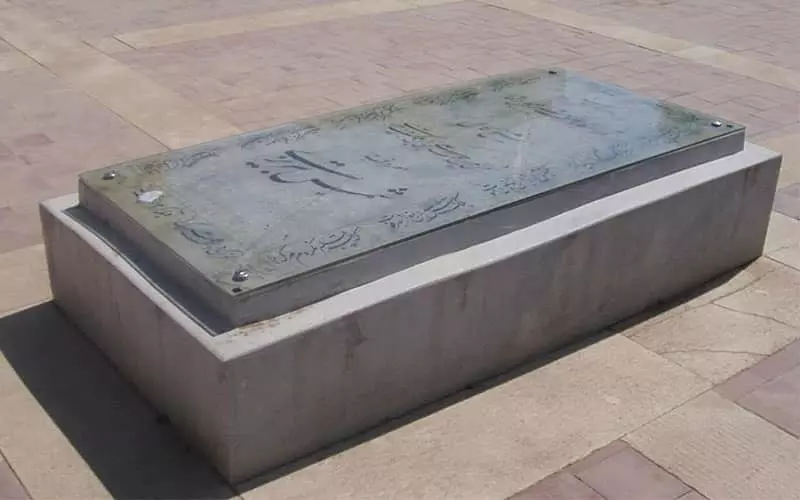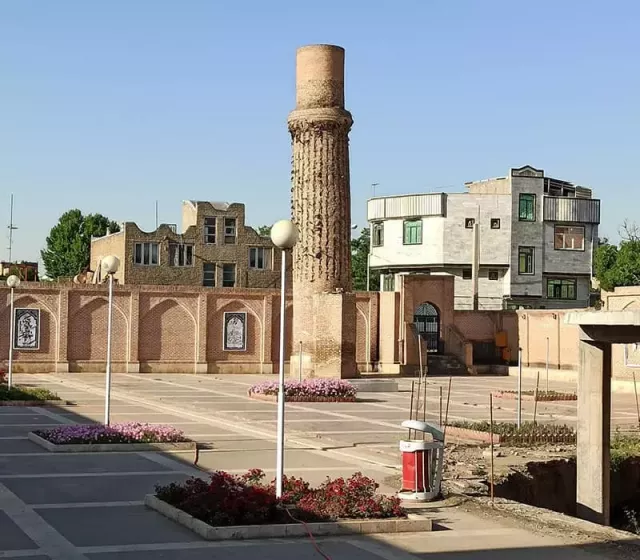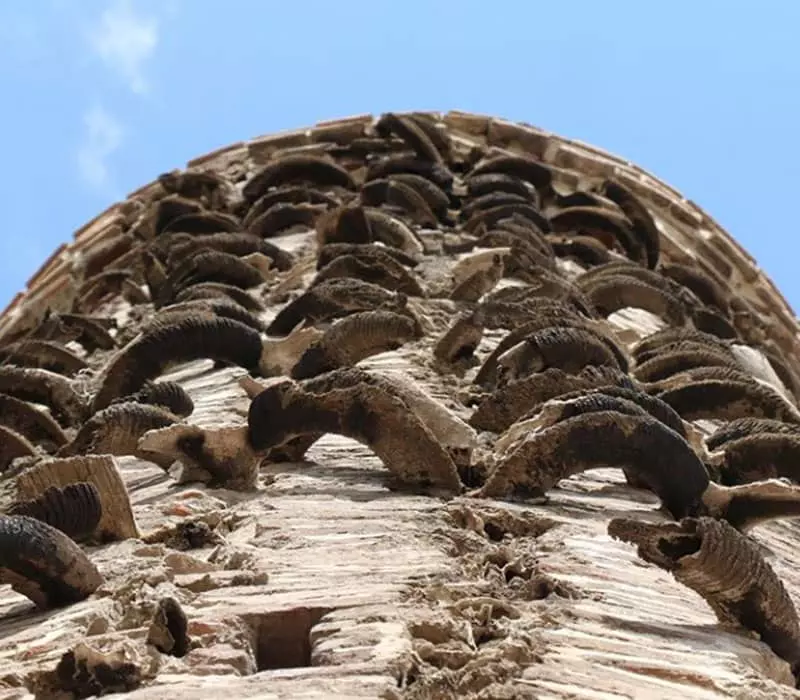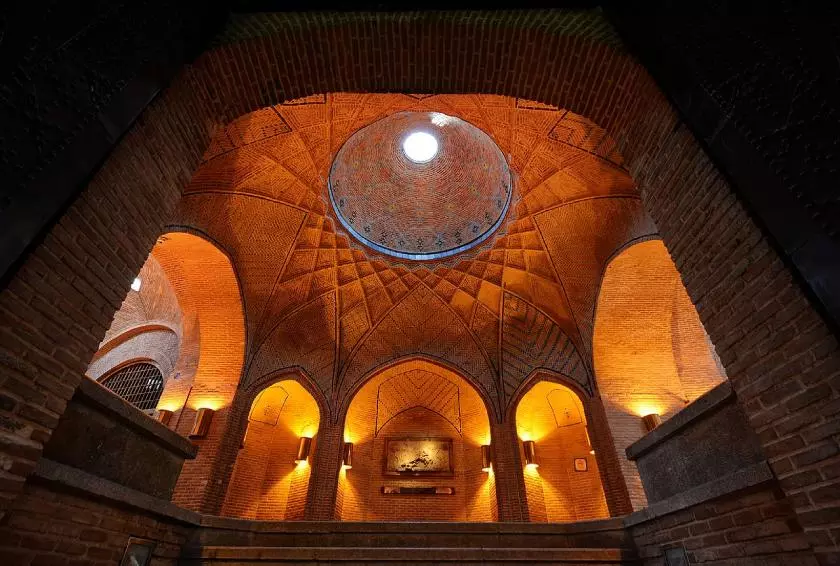Tomb of Shams Tabrizi: A Spiritual Destination in Khoy
Location of Tomb of Shams Tabrizi:
Located about three kilometers from the center of Khoy, West Azerbaijan province, amidst the houses of Shams Tabrizi Boulevard in the Imamzadeh neighborhood, stands the burial place of the renowned mystic, Shams Tabrizi. Adjacent to the tomb is a tall minaret adorned with the branches of wild goats, known as the Shams Tabrizi Tower. This tower dates back to the 6th century AH (Islamic calendar) and was registered as National Heritage of Iran with the number 966 on February 3, 1974.
Address:
West Azerbaijan Province, Khoy, Imamzadeh Neighborhood, Shams Tabrizi Boulevard
Introduction to the Tomb of Shams Tabrizi:
The Tomb of Shams Tabrizi is considered one of the tourist and pilgrimage sites in Khoy. Until recent years, Shams Tabrizi was relatively unknown, but with the efforts of the people of Khoy and the initiatives of the custodian of Shams Tabrizi, the tomb is undergoing development and urban expansion. It used to be referred to as Shams’s place for years, but little was known about it. Later, walls were built, a tombstone was placed, and it is said that he was a great man, so great that even Rumi became his disciple!
In the month of Aban in 1389 AH, an international congress on Shams Tabrizi was held in Khoy and Urmia, attended by Rumi scholars and Shams experts from both domestic and international locations. Since then, every year, Shams Tabrizi enthusiasts from Khoy and other cities of Iran, and even neighboring countries, gather in a ceremony to honor this Sufi and mystic on the 7th of Mehr. Plaques with verses from Rumi and other poets are installed on the walls of the tomb compound.
In this tomb, there is only one sarcophagus, one minaret, and a gravestone, and that encompasses Shams Tabrizi’s entire presence in his tomb. He once said about himself:
“I am a stranger, and it is fitting for a stranger to stay in a caravanserai.”

Another historical and valuable element of this complex is the Shams Tabrizi Minaret, dating back to the 6th century AH. It is considered one of the notable attractions of West Azerbaijan province, registered as National Heritage of Iran with number 966 on February 3, 1974. This minaret, situated in the courtyard of Shams Tabrizi’s tomb, bears the presence of melodious Iranian Sufis and mystics.
The Shams Tabrizi Minaret is a beautiful tower that was originally located in the middle of Meshjari Garden in the northwest corner of Khoy city. Today, amidst the new urban constructions, it stands in Shams Tabrizi neighborhood in Khoy. The mentioned minaret, with a diameter of 3.40 meters and a height of 15 meters, is located 10 meters away from the tomb.
History of Shams Tabrizi Minaret:
The Shams Tabrizi Minaret is a remaining structure associated with the tomb of the same name, situated on the grave attributed to Shams Tabrizi in Khoy city. The outer surface of this minaret is decorated with branches of wild goats that Shah Ismail Safavi hunted during his 40-day stay in the Chalak Khanah mountains near Khoy.
Remaining documents and miniature images from Shams Tabrizi’s tomb in Khoy indicate that initially, there were three minarets around Shams’s grave. The image of these three minarets is mentioned in the book “Description of the Journey of Iraqain” dated 942 AH, drawn by Sultan Suleiman of the Ottoman Empire during his journey to Khoy and the pilgrimage to Shams Tabrizi’s tomb. It depicts his military campaign route and illustrates the location of the minarets.
Years later, one of the minarets disappears; however, tourists during the Qajar period and Jahangir Mirza (died 1287 AH) mention two minarets. According to credible sources and local elders, around 120 years ago, one of the minarets is demolished, and currently, only one remains.

Architecture of Shams Tabrizi Minaret:
The architectural style of the Shams Tabrizi Minaret is closely related to the structures of the Seljuk period found in the Kerman region, known as “Mil Qavordi.” By studying archaeology, insights into the time and reason for its construction can be easily inferred from the examination of branches and skull motifs.
The minaret structure is cylindrical and, as no comprehensive studies have been conducted yet, there are no signs or traces of any remains of structures (Shams’s tomb or Shah Ismail I’s palace) that could strongly suggest its association with them. The minaret is hollow, and a spiral staircase from the entrance at its base leads to the top, where the muezzin’s platform facing the qibla is located.
The base and approximately 50 centimeters above it are constructed with stone, although some of its base may be buried under sediment due to floods, etc. From this point onward, bricks are used, and goat horns are placed in the middle of the bricks. The minaret is divided into three sections in terms of form: the bottom and its smaller top section are simple, while the middle section is adorned with branches of wild goats. The purpose of its construction was likely to showcase the king’s power, as he had managed to hunt wild goats to such an extent that their horns were used in the external surface decoration of the minaret.
A unique feature of this structure is the installation of branches of wild goats on its external body, accompanied by the skull of the animal as decoration on the minaret. No decorative elements are used in the brickwork and form of the minaret.
Regarding the construction of minarets in important cities that held significance in terms of Sughd al-Jaysh, Saeed Nafisi writes:
“In important settlements located along the roads, they would light a fire on a height at night, and they called the tower built for this purpose an ‘Atashgah.’ This term was translated into Arabic and referred to as ‘Minar’ and ‘Minaret,’ then it was used in mosques. Through the fire lit atop these towers, they would convey news, signs, and guidance from afar, making people aware of dangers and events. It is possible that one of these minarets serves as a memorial column for the Alp Arslan Seljuk’s war with Romanos Diogenes, the Roman Emperor, in Malazgirt. His victory in this battle marked the fate of the Muslims in the region, and the Roman Empire gradually transformed into a Muslim-majority country. The mentioned minaret gained a sacred status among the people of this borderland.”

After Shams Tabrizi’s stay in Khoy and his passing, his funeral was buried alongside it, and the name “Minaret of Shams Tabrizi” emerged. Since Shah Ismail Safavi was himself a mystic and Sufi, he ordered the construction of his palace next to the shrine of Shams Tabrizi.
Who Was Shams Tabrizi?
Mohammad ibn Ali ibn Malek Dad Tabrizi, known as Shams al-Din or Shams Tabrizi, was a famous Iranian Muslim Sufi of the 7th century AH. Shams studied under masters such as Shams Khonji and then devoted himself to spiritual practice, gaining knowledge from elders like Pir Saleh Baf and Pir Sijasi. He was a passionate traveler, spending his life journeying and seeking wisdom from various sources. Shams met Rumi, and with his strong and warm personality, he transformed Rumi’s life. Before encountering Shams Tabrizi, Rumi was a scholar and jurist, teaching religious sciences in four reputable schools. He was revered by scholars, and elders walked in his footsteps.
With the arrival of Shams Tabrizi, Rumi changed his attire, becoming a practitioner of ecstasy, recitation, and poetry. This transformation was unbearable for the people of Konya, especially Rumi’s followers. The public and the elite became angry, disciples revolted, and everyone harbored animosity towards Shams. Eventually, Shams Tabrizi left Konya.
Rumi was constantly in search of news about Shams Tabrizi but found no sign of him. Shams Tabrizi had told Sultan Walad that he would go somewhere where no one could find a trace of him after his disappearance.
Some believe that Shams is buried in Konya, while others consider his tomb to be in Khoy. In the place known today as the Tomb of Shams Tabrizi, besides a gravestone attributed to Shams and a sarcophagus of this great man, a tall minaret is also visible. A single verse from Rumi is engraved on the tombstone:
“Shams Tabriz, who is the absolute light, is the sun and radiance of the truth.”

Tips for Visiting the Tomb of Shams Tabrizi:
Visiting this site is free of charge.
It is possible to visit the tomb at any hour of the day or night.
Avoid writing graffiti on the minaret and refrain from littering.
Frequently Asked Questions:
Where is the Tomb of Shams Tabrizi located?
The Tomb of Shams Tabrizi is situated in Khoy, West Azerbaijan Province, in the Imamzadeh neighborhood, Shams Tabrizi Boulevard.
What are the components of the Tomb of Shams Tabrizi?
The tomb consists of only one cenotaph, one minaret, and a gravestone. These elements encompass Shams Tabrizi’s entire memorial complex.
Is the Shams Tabrizi Minaret nationally registered?
Yes. The Shams Tabrizi Minaret was registered on the National Heritage List of Iran on the 14th of Bahman, 1352 (February 3, 1974), with the registration number 966.
What features does the Shams Tabrizi Minaret have?
The external surface of the minaret is adorned with branches of wild goats. During Shah Ismail Safavi’s 40-day stay in the Chelcheh Khanah mountains, he hunted wild goats, and their horns were used for decorating the exterior of the minaret.








